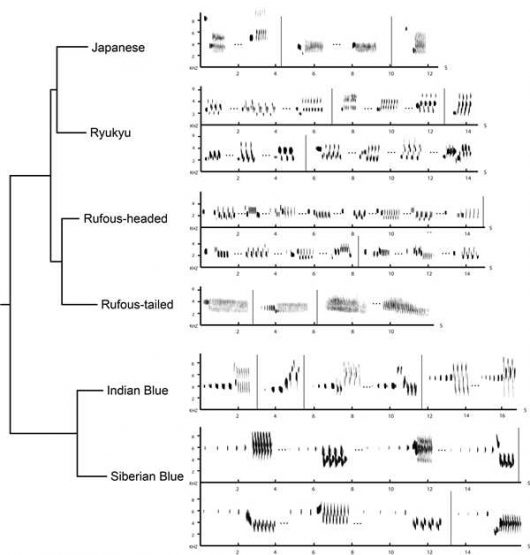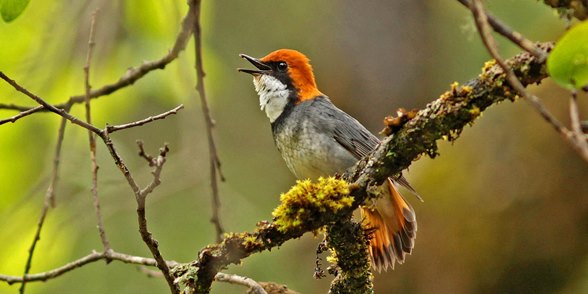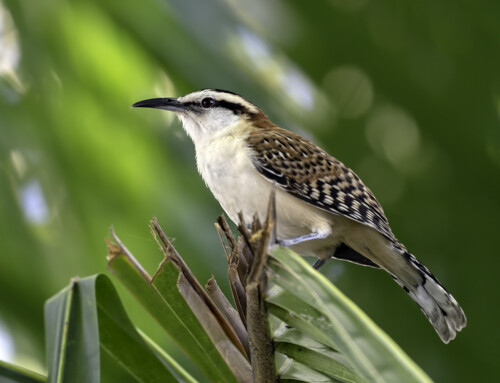Or has the Rufous-headed Robin already gone extinct?
LINKED PAPER
Phylogenetic relationships, song and distribution of the endangered Rufous-headed Robin Larvivora ruficeps. Zhao, M., Alström, P., Hu, R., Zhao, C., Hao, Y., Lei, F. & Qu, Y. 2017. IBIS. DOI: 10.1111/ibi.12426. VIEW
Around 10% of the World’s passerines are threatened (BirdLife Data Zone), mainly as a result of human activities. One of these is the Rufous-headed Robin Larvivora ruficeps, which breeds in central China and probably winters in Southeast Asia. It is currently classified as Endangered (EN), which is the category second closest to Extinct (in the wild or anywhere). However, we suggest that on current knowledge it should probably be upgraded to Critically Endangered.
The adult male Rufous-headed Robin has a beautiful, strikingly coloured plumage, whereas the female is very non-descript – as in many of its relatives. It was previously placed in the “nightingale genus” Luscinia, but was tentatively suggested to be moved to Larvivora based on structural, song and behavioural similarities to two the Indian Blue Robin Larvivora brunnea and Siberian Blue Robin L. cyane (Sangster et al. 2010).
Relationships confirmed
In a recently published study (Zhao et al. 2017), we and co-authors used mitochondrial and nuclear DNA sequence data to show that the Rufous-headed Robin is indeed properly placed in the genus Larvivora, where we found it to be sister to the Rufous-tailed Robin L. sibilans, which breeds in eastern Russia and northeast China. In turn, these two are most closely related to the sister pair Ryukyu Robin L. komadori (endemic to the Danjo and Ryukyu Islands, Japan) and Japanese Robin L. akahige (mainly Japan). See Figure 1.
The sister relationship between Rufous-headed and Rufous-tailed Robins was unexpected. Unlike all other Larvivora species, the Rufous-tailed Robin is sexually monomorphic, and both sexes are fairly similar to female Rufous-headed Robin (and other female congeners) (cf. Fig. 1).

Complex song evolution
In the same paper, we also analysed the songs of the six species of Larvivora. The rich, varied, beautiful song of Rufous-headed Robin is very different from the stereotyped drawn-out trill of the Rufous-tailed Robin, whereas it is closely similar to the song of the Ryukyu Robin. However, the song of the Rufous-tailed Robin is more similar to the song of the Japanese Robin. See Figure 2; recordings of all species are available at Xeno-canto.org.
In other words, the song evolution of these birds is complex. We concluded that the similarities in song between Rufous-headed and Ryukyu Robins and between Rufous-tailed and Japanese Robins are not due to shared history. We discussed two alternative hypotheses to explain this pattern, both of which involved parallel song evolution.

Distribution and status 1905–2015
During the breeding season the Rufous-headed Robin has been observed in temperate mixed coniferous and deciduous forest at 2400–3000 m in Sichuan and Shaanxi Provinces in central China (Fig. 3). Our paper summarized all known observations of the species. It was first discovered on the mountain Taibai Shan in Shaanxi Province in July 1905 (Hartert 1907 a, b), but it has not been observed in that province since then. All subsequent breeding period records are from Sichuan Province.
The first sighting from Sichuan was made in June 1985, when three singing males were found in the Jiuzhaigou national park (BirdLife International 2001). Since then, it has only been observed at three other nearby nature reserves in Sichuan, and in the last 25 years it has only been found at two of these (Jiuzhaigou and Baihe), with up to 8 individuals in a year. One of the last observed males in Jiuzhaigou was last seen in late May 2015 in the mouth of a Least Weasel Mustela nivalis (Sid Francis in litt.)!
The winter quarters are not safely known, and there are only three records away from China, two from Malaysia in March–April (McClure 1963, Malaysian Nature Society-Bird Conservation Council Records Committee 2014), and one from Cambodia in November (Mahood et al. 2013). The dates suggest that all three birds were on migration.

No records since 2015
No documented observations were made in 2016 and 2017, despite intensive searches at the two classic sites. In early June 2017, an audio survey targeting this species was undertaken in Baihe nature reserve, led by Sid Francis (Francis in prep.). Unfortunately no Rufous-headed Robins were found during the survey (Francis in prep.).
Potential range
In our paper, we used ecological niche modelling to estimate the suitable habitats and potential breeding distribution of the Rufous-headed Robin based on its known habitat preferences. Our conclusion was that in addition to its formerly known sites it is most likely to occur in north and central Sichuan, south Gansu, south Shaanxi and southeast Tibet (Fig. 3).
Reasons for decline
BirdLife (2001) suggested habitat loss and fragmentation as the most likely causes of the decline of the Rufous-headed Robin. We question this, because there are still large expanses of seemingly suitable forest areas in the mountains of central China, including multiple large protected areas. We suggest that the decline has more to do with conditions and threats along its migration routes and in its winter quarters. For example, there is evidence of males being illegally captured and sold in the cagebird market. At present, the species might have reached a critically low population size, making it very unlikely for potential mates to meet.
Change of Red List status warranted?
The great rarity, especially the complete lack of observations since June 2015 from the only two localities where it has been observed in the last 25 years, suggests that the Rufous-headed Robin might qualify for the Critically Endangered category. However, most of the potential breeding areas suggested by our study are in poorly accessible areas. Moreover, the Rufous-headed Robin is extremely secretive, and therefore very hard to find unless singing. Accordingly, there is still a chance that new breeding sites will be discovered.
Another rare Chinese robin, the Blackthroat Calliope obscura, had only been seen a handful of times since it was first described in the 1890s, until a seemingly healthy breeding population was discovered in protected areas in Shaanxi Province in 2011 (Song et al. 2014).
Hopefully, the charismatic Rufous-headed Robin still has a future!
We are most grateful to the photographers for providing photos for Fig. 1: Pete Morris, Craig Brelsford, Yoshihito Goto, Kazunori Kimura, Guy Miller, Pranjal J. Saikia, and Jonathan Martinez for assistance with obtaining photos. Paul Donald for providing info on threatened passerines.
References
BirdLife International. 2001. Threatened birds of Asia: the BirdLife International Red Data Book. Cambridge, UK: BirdLife International.
Hartert, E. 1907a. Description of a new species of bird from northern China. Bulletin of the British Ornithologists’ Club 19: 50
Hartert, E. 1907b. On some rare species of the genus Larvivora from China. IBIS 49: 621–623. VIEW
Mahood, S.P., Eaton, J.A. & Leader, P.J. 2013. Second record of Rufous-headed Robin Luscinia ruficeps outside its breeding range and a description of its first-winter plumage. BirdingAsia 19: 43–47. VIEW
McClure, H.E. 1963. Is this one of the rarest birds in the world? Malayan Nat. J. 17: 185–187.
Sangster, G., Alström, P., Forsmark, E. & Olsson, U. 2010. Multilocus phylogenetic analysis of Old World chats and flycatchers reveals extensive paraphyly at family, subfamily and genus level (Aves: Muscicapidae). Molecular Phylogenetics and Evolution 57: 380–392. VIEW
Song, G., Alström, P., Zhang, Y., Gao, X., Gong, H., Holt, P.I., Quan, Q., Yin, Z. & Lei, F. 2014. Rediscovery of an enigmatic Chinese passerine, the Blackthroat Calliope obscura: plumage, vocalizations, distribution, habitat choice, nesting and conservation. Journal of Ornithology 155: 347–356. VIEW
Zhao, M., Alström, P., Hu, R., Zhao, C., Hao, Y., Lei, F. & Qu, Y. 2017. Phylogenetic relationships, song and distribution of the endangered Rufous-headed Robin Larvivora ruficeps. IBIS 159: 204–216. VIEW
Image credit
Featured image: Rufous-headed Robin Larvivora ruficeps © Pete Morris
If you want to write about your research in #theBOUblog, then please see here.





